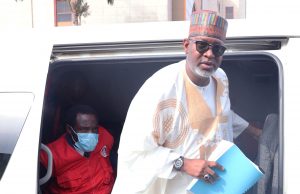Ruinous Hurricane Fiona reaches Category 4 as it moves north, leaving disaster-stricken areas on slow road to recovery | CNN

CNN
—
With Category 4 Hurricane Fiona poised to sideswipe Bermuda later this week, people in the storm’s deadly wake still faced days without basic utilities Wednesday – including much of Puerto Rico, where most were left without power and running water.
Only about 395,200 of Puerto Rico’s 1.5 million utility customers had power by 6:30 p.m. Wednesday, according to the island’s emergency portal system. And about half of the island’s customers still were without running water, Federal Emergency Management Agency Administrator Deanne Criswell said Wednesday morning.
Water is the top concern for residents like Carlos Vega, whose town of Cayey in the mountains of east-central Puerto Rico faced not only utility outages but also partially collapsed roads – an effect of the major flooding and more than 2 feet of rain that parts of Puerto Rico were hit with.
“(Being without) power … we can face that and we can deal with that. The biggest concern is with our water. Can’t live without water,” Vega told CNN on Tuesday.
Fiona killed at least five people in the Caribbean as it tore through the region last weekend and into this week, including one in Guadeloupe, two in Puerto Rico, and two in the Dominican Republic.
Fiona also whipped parts of the Turks and Caicos islands on Tuesday with sustained winds of almost 125 mph, officials said. That left many areas without power, including on Grand Turk, South Caicos, Salt Cay, North Caicos and Middle Caicos, said Anya Williams, the deputy governor of the islands.
No deaths or serious injuries had been reported in Turks and Caicos as of Tuesday evening, Williams said.
Fiona’s flooding especially left critical infrastructure damage in Puerto Rico and then the Dominican Republic, which the storm crossed Monday. More than 1 million utility customers in the Dominican Republic had no water service as of Wednesday morning, and more than 349,000 customers were without power, according to Maj. Gen. Juan Méndez García, director of the country’s emergency operations center.
The power outages come as parts of the Caribbean face stifling heat. Heat indices – what the air feels like when combining temperature and humidity – of 105 to 109 degrees are expected Wednesday in north-central, northwestern and western portions of Puerto Rico, the National Weather Service said.
The landfall in Puerto Rico on Sunday came nearly five years after Hurricane Maria devastated the island, leaving thousands dead and cutting power to and water service to more than 1 million people for what would become months.
Storm presses north and could threaten Bermuda and Atlantic Canada
Fiona, after its center passed the Turks and Caicos as a Category 3 storm, strengthened to Category 4 – sustained winds of at least 130 mph – early Wednesday over the Atlantic.
By around 5 p.m. ET Wednesday, it was centered about 615 miles southwest of Bermuda, heading north with sustained winds of 130 mph, the Miami-based National Hurricane Center said.
Fiona is expected to approach Bermuda late Thursday, potentially still as a Category 4 storm, forecasters said.
“Fiona is forecast to be a hurricane-force cyclone through Saturday,” the hurricane center said.
Fiona’s powerful center is currently expected to pass west of Bermuda, sparing the British island territory its worst winds. But sustained winds of at least tropical-storm force – 39 to 73 mph – are expected to reach Bermuda by late Thursday or early Friday, the center said.
The US State Department issued a travel advisory Tuesday urging US citizens to reconsider travel to Bermuda because of the storm. The department also authorized family members of US government personnel to leave the island in anticipation of the storm.
Though the storm isn’t expected to track near the US East Coast, it could generate onshore waves of 8 to 10 feet there over the weekend, CNN meteorologist Chad Myers said Wednesday.
“It’s not a good weekend to go to the shore and get in the water – it’s time to stay out of the water,” Myers said of the East Coast.
Fiona could affect portions of Atlantic Canada as a powerful hurricane-force cyclone late Friday and Saturday, potentially hammering the region with high winds, storm surge and heavy rainfall.
The storm has strengthened over the past few days – it made landfall in Puerto Rico and the Dominican Republic as a Category 1 hurricane before battering both with outer bands as it moved over water and toward the Turks and Caicos as a storm in Categories 2 and 3.
Photos: Hurricane Fiona slams the Caribbean
Ricardo Hernandez/AP
Nicasio Gil walks through the stagnant water left by the swollen Duey River while grappling with the aftermath of Hurricane Fiona in Higuey, Dominican Republic, on Tuesday, September 20.
Photos: Hurricane Fiona slams the Caribbean
Maxar Technologies/Reuters
A satellite image shows flooded fields and buildings in Cerrillos, Puerto Rico, on Tuesday.
Photos: Hurricane Fiona slams the Caribbean
Jose Jimenez/Getty Images
A damaged plantain crop field is seen Tuesday in Guanica, Puerto Rico.
Photos: Hurricane Fiona slams the Caribbean
Stephanie Rojas/AP
A photo album belonging to Luis Ramos Rosario lies in the mud inside his flooded home in Cayey, Puerto Rico.
Photos: Hurricane Fiona slams the Caribbean
Ricardo Hernandez/AP
Residents work to recover belongings after flooding in the Los Sotos neighborhood of Higuey on Tuesday.
Photos: Hurricane Fiona slams the Caribbean
Ricardo Rojas/Reuters
A man in El Seibo, Dominican Republic, looks at his damaged house on Tuesday.
Photos: Hurricane Fiona slams the Caribbean
Alejandro Granadillo/AP
Streets are flooded on Salinas Beach after Hurricane Fiona moved through Salinas, Puerto Rico, on Monday, September 19.
Photos: Hurricane Fiona slams the Caribbean
Ricardo Arduengo/Reuters
Members of the Puerto Rico National Guard rescue a woman stranded at her house in Salinas on Monday.
Photos: Hurricane Fiona slams the Caribbean
Ricardo Arduengo/Reuters
A member of the Puerto Rico National Guard searches for people in Salinas on Monday.
Photos: Hurricane Fiona slams the Caribbean
Stephanie Rojas/AP
Residents affected by Hurricane Fiona rest at a storm shelter Monday in Salinas.
Photos: Hurricane Fiona slams the Caribbean
Ricardo Arduengo/Reuters
Children swim in a flooded street in Salinas on Monday.
Photos: Hurricane Fiona slams the Caribbean
Jose Rodriguez/AFP/Getty Images
A woman stands outside her flooded house in Salinas on Monday.
Photos: Hurricane Fiona slams the Caribbean
-/AFP/AFP via Getty Images
A person cooks in the dark Monday after losing power in San Juan, Puerto Rico.
Photos: Hurricane Fiona slams the Caribbean
Alejandro Granadillo/AP
A woman clears debris on her flooded property in Salinas on Monday.
Photos: Hurricane Fiona slams the Caribbean
Alejandro Granadillo/AP
Nelson Cirino looks at his bedroom after the winds of Hurricane Fiona tore the roof off his house in Loíza, Puerto Rico, on Sunday, September 18.
Photos: Hurricane Fiona slams the Caribbean
Ricardo Arduengo/Reuters
People clear a road from a fallen tree in Yauco, Puerto Rico, on Sunday.
Photos: Hurricane Fiona slams the Caribbean
This satellite image shows Hurricane Fiona in the Caribbean on Sunday.
Photos: Hurricane Fiona slams the Caribbean
Alejandro Granadillo/AP
Nelson Cirino secures the windows of his home as the winds of Hurricane Fiona blow in Loíza on Sunday.
Photos: Hurricane Fiona slams the Caribbean
Ricardo Rojas/Reuters
Workers of the Social State Plan prepare food rations in Santo Domingo, Dominican Republic, on Sunday.
Photos: Hurricane Fiona slams the Caribbean
Alejandro Granadillo/AP
Jetsabel Osorio stands in her house in Loíza on Saturday, September 17. It was damaged five years ago by Hurricane Maria.
Photos: Hurricane Fiona slams the Caribbean
Ricardo Arduengo/Reuters
Boats sit secured to mangroves as Fiona approaches Cabo Rojo, Puerto Rico, on Saturday.
‘We can’t take it any longer’
Many in the Dominican Republic and Puerto Rico still are grappling with Fiona’s aftermath and will likely face a prolonged relief and recovery process.
In Nizao, a small city in southern Dominican Republic, a woman tearfully told CNN affiliate Noticias SIN that Fiona’s winds destroyed her home.
“Thank God my girls (are) safe. I managed to cover them with something and block them with a washing machine,” she told Noticias SIN this week.
Another woman in Nizao who was clearing mud from belongings told Noticias SIN that she was frustrated because flooding frequently damages the region. This week, she left all belongings behind when floodwater encroached, she said.
“We can’t take it any longer. Every year we lose our bed, clothes, food, everything,” the second woman told Noticias SIN.
More than 610 homes in the Dominican Republic have been destroyed, and some communities were cut off from aid due to the storm, said García, the nation’s emergency operations center director.
Puerto Rico Gov. Pedro Pierluisi said on Twitter Wednesday that the federal government has approved a major disaster declaration request for the island, which ensures additional help from FEMA.
Though US President Joe Biden approved an emergency declaration Sunday, a major disaster declaration will bring additional resources – primarily individual assistance in the form of funding for housing and other needs, as well as public assistance to provide for the permanent rebuilding of damaged infrastructure.
Restoration crews face challenges
The governor expected “a large portion of the population” would have power restored by late Wednesday, with the exception of the island’s southern region, which has suffered the most severe damage, he said Tuesday.
But restoration crews faced challenges: Many lines thought to have been repaired were temporarily knocked back offline because of various equipment issues, according to Josué Colón, executive director of the Puerto Rico Electric Power Authority.
Crews could also encounter issues that require a pause in work so that an already impaired grid is not overloaded, a spokesman for the power provider, LUMA Energy, said Wednesday.
On Wednesday, Pierluisi will take an aerial tour of the island with Criswell, the FEMA administrator, he said. Criswell arrived on Tuesday to determine what additional federal help is needed, and that day surveyed damage with the governor in the city of Patillas.
“The community there … (had) severely impacted roads, and bridges were damaged. Water was flooding the streets, and … other parts of the community (were) inaccessible,” Criswell said during a news conference Wednesday.
“But I also saw a resilient Puerto Rico,” she said. “I met with a woman named Anna, who opened up her own home in her own driveway to help create a path for the community. With the bridge that was washed away, her home became that pathway to help give food and water to the rest of her community.”
The storm is a catastrophic blow to Puerto Rico, which was still recovering in some areas from when Hurricane Maria ripped through the island in 2017, inflicting widespread infrastructure damage and destroying homes.
The damage caused by Fiona is “devastating” and “catastrophic” in the island’s center, south and southeast regions, Pierluisi said Tuesday.
Across the island, more than 800 people were housed in dozens of shelters Wednesday, according to Puerto Rico’s Housing Secretary, William Rodriguez.
CNN’s Leyla Santiagio in Puerto Rico and CNN’s Robert Shackelford, Jamiel Lynch, Amanda Musa, Chris Boyette, Taylor Ward and Geneva Sands contributed to this report.







